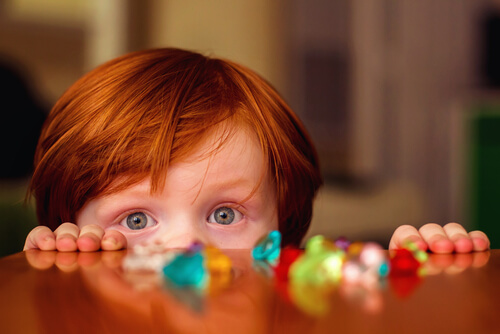12 Games for 4-Year-Old Children

These 12 games for 4-year-old children are aimed at cognitive, emotional and motor development. They are also a great way to keep them entertained and to channel their energy throughout the day.
In this article we’ll share with you the importance of a child’s emotional and cognitive development in accordance to Piaget’s phases of development.
We’ll also help you discover which games can be used to stimulate their development in a simple, enjoyable and fun way.
Games for 4-year-old children
Emotional development is the process by which a person discovers their own being and defines their internal “I.” Its development includes identity, self-esteem, security and confidence in one’s abilities.
Emotional development also includes the ability to recognize our own feelings and those of the people around us.
The knowledge to handle different problems and situations will be obtained as their emotional development occurs.

Emotional development allows children to become aware of their being and therefore, their place in the world.
The characteristics that 4-year-old children present in relation to their emotional development are the following:
- Competitiveness in games becomes more objective. From now on they will get upset when they lose an activity, or very happy when they win.
- They imitate adults. 4-year-old children will try to put themselves in adults’ shoes in order to imitate them with expressions, repetitions of what we say or even dressing up in our clothes.
- The famous age of asking “Why?” They do this in order to try to understand everything. Until now, many questions could be solved with a simple “because I say so.” At this age, children will demand more of a justification.
Games to stimulate emotional development
The following games and activities will help stimulate your child’s emotional development. They’re very simple activities that you can do with them without having to buy new toys or use many materials. Here are a few examples:
- Make masks with cardboards with different emotions.
- Show your child pictures of when they were younger and explain the feelings they felt in that moment.
- While playing with their toys, help the child notice the toy’s emotions: “Look how happy the bunny is.”
- Play in front of a mirror and make different faces corresponding to different emotions.
- Play a game to guess a person’s emotions.
Games to stimulate cognitive development
Cognitive development corresponds to the effort that your child makes to understand and act in the world.
During this stage of life, they will discover new ways to act. This development can be divided into different phases depending on the child’s age.
According to Piaget, these are the phases of cognitive development:
- From 0 to 24 months: Sensory-motor. The child’s behavior is primarily motor. They don’t think about concepts.
- 2 to 7 years old: Pre-operational. This is the most important stage for a child’s cognitive development. It’s also the longest phase. During the pre-operational phase, the child develops their capacity for thinking and using language.

- 7 to 11 years old: Concrete operations. They will be able to solve simple problems. This will be the most social stage of their life thus far. The child will have developed logical inductive and deductive reasoning. Their personality will start to be defined. Moral and ethical development also starts during this phase.
Other games and activities
These games and activities will help stimulate cognitive development. They can be carried out individually or with family and friends.
- Remember objects that they’ve seen in pictures.
- Establish similarities between objects in terms of color and shape.
- Exercises with illustrations in which the child will have to differentiate between:
- Up and down.
- In and out.
- Near or far.
- Small puzzles of 24 pieces or more.
- Completing a simple maze.
- Playing games to imitate their favorite characters.
- Little plays. Age 4 is the perfect time to point your child towards extracurricular activities that can develop their interpretive capacity.
These activities are all very simple and you can undertake them with 4-year-old children (or even older ones) without having to go out to buy new toys or materials that you don’t have at home. It’s all about using the resources that are already present in the house.
Keep in mind that the aim of these games is to stimulate their development and also to spend time with them. And yes, you can buy toys and materials to make crafts, however this shouldn’t become a constant necessity to have fun.
All cited sources were thoroughly reviewed by our team to ensure their quality, reliability, currency, and validity. The bibliography of this article was considered reliable and of academic or scientific accuracy.
- Zurita, G., Sánchez, J., & Nussbaum, M. (1999). Usabilidad de juegos educativos. Taller Internacional de Software Educativo. TISE, 99. https://www.researchgate.net/profile/Gustavo_Zurita2/publication/228360083_Usabilidad_de_juegos_educativos/links/00b49526e6a6839c92000000/Usabilidad-de-juegos-educativos.pdf
- Arias, C. M. (2016). Los juegos didácticos y su influencia en el pensamiento lógico matemático en niños de preescolar de la Institución Educativa El Jardín De Ibagué–2015. http://repositorio.uwiener.edu.pe/handle/123456789/625
- Levine, S. C., Ratliff, K. R., Huttenlocher, J., & Cannon, J. (2012). Early puzzle play: a predictor of preschoolers’ spatial transformation skill. Developmental psychology, 48(2), 530-540. https://www.ncbi.nlm.nih.gov/pmc/articles/PMC3289766/
- Montero, M. M. y Alvarado, M. D. L. Á. M. (2001). El juego en los niños: un enfoque teórico. Revista educación, 25(2), 113-124. https://revistas.ucr.ac.cr/index.php/educacion/article/view/3585
- Ruiz, L. M. (2013). Influencia del programa de juegos educativos en el mejoramiento del desarrollo cognitivo de los niños de 4 años del cee “rafael narváez cadenillas” de la ciudad de trujillo del 2012. [Tesis de grado, Universidad Nacional de Trujillo]. Repositorio Institucional UNITRU. http://dspace.unitru.edu.pe/handle/UNITRU/1625
- Linaza, J. L., & Maldonado, A. (1990). Juego y desarrollo infantil. https://www.researchgate.net/profile/Jose_Linaza/publication/268265700_El_juego_en_el_desarrollo_infantil/links/55f05b6608ae0af8ee1d17d3.pdf
- Noda, S., Shirotsuki, K., & Nakao, M. (2019). The effectiveness of intervention with board games: a systematic review. BioPsychoSocial medicine, 13(1), 1-21. https://www.ncbi.nlm.nih.gov/pmc/articles/PMC6802304/
- Bueno Loja, MI, & Sanmartín Morocho, MA (2015). Las rimas, trabalenguas y canciones como estrategias metodológicas para estimular el desarrollo del lenguaje en niños y niñas de 3 a 4 años de edad del Centro Infantil del Buen Vivir “Ingapirca”, de la comunidad de Ingapirca de la parroquia Santa Ana, cantón Cuenca, Provincia del Azuay [Tesis de grado, Universidad Politécnica Salesiana]. Repositorio Institucional de la Universidad Politécnica Salesiana. https://dspace.ups.edu.ec/handle/123456789/8892
- Hijos, Q. y Alejandro. (2020). Teoría educativa sobre tecnología, juego y recursos en didáctica de la educación infantil . Prensas de la Universidad de Zaragoza. https://books.google.es/books?id=LBnLDwAAQBAJ&dq=juegos+de+tecnología%C3%ADa+para+ni%C3%B1os+de+4+a%C3%B1os&lr=&hl=es&source=gbs_navlinks_s
This text is provided for informational purposes only and does not replace consultation with a professional. If in doubt, consult your specialist.








